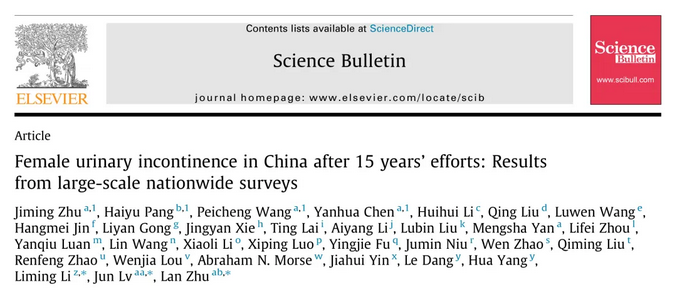
Urinary incontinence is a common condition among women, characterized by involuntary leakage of urine. It severely impacts daily activities and leads to embarrassment, depression, and social isolation for affected women, placing a heavy economic burden on them, their family, and the wider society. Professor Zhu Lan has dedicated over a decade to researching the prevention and treatment of this condition. Her team's epidemiological study in 2006 revealed that the prevalence rate of urinary incontinence among adult Chinese women was 30.9%. In recent years, multiple factors have all influenced the prevalence of female urinary incontinence in China, including accelerated population aging, increased health awareness, and the continued promotion of pelvic floor rehabilitation techniques. Given the changes, it is now necessary to investigate the epidemiological characteristics of this condition under these new circumstances.
From 2019 to 2021, Professor Zhu Lan's team conducted China's largest-scale epidemiological survey on urinary incontinence among adult female, using complex sampling methods to study 54,346 participants. The study revealed a 16.0% prevalence rate among women aged 20 and above, putting the case estimate at 85.8 million in 2021. Disease awareness remains low, with 48.0% of the participants recognizing it as a medical condition and only 10.1% seeking care. On a positive note, China's three-tier network for pelvic floor disease screening, prevention and treatment has improved significantly over the past 15 years, now featuring nearly 8,400 rehabilitation institutions and 10,000 qualified physicians. Data shows a clear, positive correlation between the number of rehabilitation institutions and physicians and disease awareness, and a negative correlation with prevalence.

▲The pelvic floor disease diagnosis and treatment center under the Department of Obstetrics and Gynecology, PUMCH
Urinary incontinence is preventable and treatable, and research shows that its prevalence among adult Chinese women has significantly decreased over the past 15 years. However, given China's aging population and evolving fertility policies, it remains a critical public health issue. The study recommends improving healthcare accessibility and optimizing prevention and rehabilitation strategies to further reduce prevalence and increase treatment rates, better protecting women's health.
